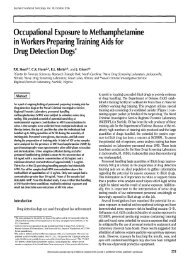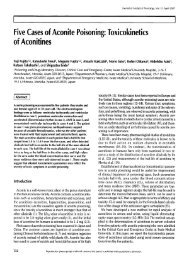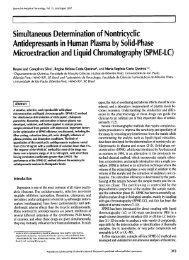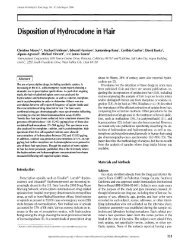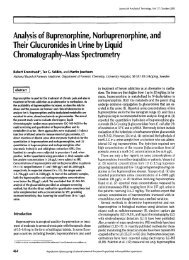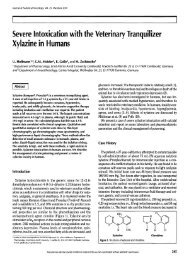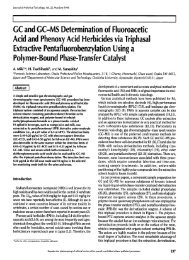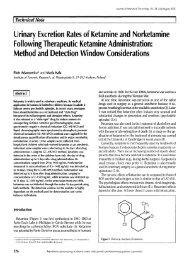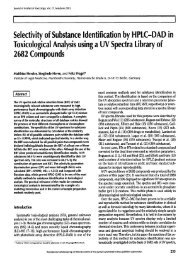(TDS) for Detection of Basic Drugs in Forensic Samples by GC-MS
(TDS) for Detection of Basic Drugs in Forensic Samples by GC-MS
(TDS) for Detection of Basic Drugs in Forensic Samples by GC-MS
Create successful ePaper yourself
Turn your PDF publications into a flip-book with our unique Google optimized e-Paper software.
Journal <strong>of</strong> Analytical Toxicology, Vol. 30, October 2006<br />
Per<strong>for</strong>mance Evaluation <strong>of</strong> Thermal Desorption System<br />
(<strong>TDS</strong>) <strong>for</strong> <strong>Detection</strong> <strong>of</strong> <strong>Basic</strong> <strong>Drugs</strong> <strong>in</strong> <strong>Forensic</strong> <strong>Samples</strong><br />
<strong>by</strong> <strong>GC</strong>-<strong>MS</strong><br />
Joseph A. Crifasi 1, Michael F. Bruder 1, Christopher W. Long 1, and Kimberly Janssen 2<br />
1Sa<strong>in</strong>t Louis University <strong>Forensic</strong> Toxicology Laboratory, St. Louis, Missouri and 2Sa<strong>in</strong>t Louis University Cl<strong>in</strong>ical Laboratory<br />
Science Program, St. Louis, Missouri<br />
Abstract I<br />
Stir bar sorptive extraction is an <strong>in</strong>novative sample extraction<br />
technique that can be used to process blood, ur<strong>in</strong>e, and tissue<br />
samples <strong>for</strong> rout<strong>in</strong>e drug screen<strong>in</strong>g <strong>in</strong> the <strong>for</strong>ensic toxicology<br />
laboratory. The Gerstel Twister TM desorption unit (TDU) system is<br />
a multifunctional desorption unit capable <strong>of</strong> determ<strong>in</strong><strong>in</strong>g the<br />
presence <strong>of</strong> analytes from liquid samples after extraction us<strong>in</strong>g the<br />
Twister stir bar. The TDU desorption system was evaluated <strong>for</strong> use<br />
<strong>in</strong> comb<strong>in</strong>ation with gas chromatography-mass spectrometry<br />
(<strong>GC</strong>-<strong>MS</strong>) <strong>for</strong> determ<strong>in</strong><strong>in</strong>g the presence <strong>of</strong> basic drugs <strong>in</strong> <strong>for</strong>ensic<br />
samples. Human blood <strong>for</strong>tified with known quantities <strong>of</strong> drugs<br />
was used to evaluate sample diluents, extraction time, <strong>in</strong>jection<br />
parameters and recovery. Case specimens conta<strong>in</strong><strong>in</strong>g drugs<br />
typically encountered <strong>in</strong> <strong>for</strong>ensic samples were evaluated us<strong>in</strong>g the<br />
desorption method and compared with a liquid-liquid extraction<br />
method followed <strong>by</strong> <strong>GC</strong>-<strong>MS</strong> analysis. This evaluation<br />
demonstrated that the TDU desorptive method worked equally as<br />
well as the rout<strong>in</strong>e extraction method <strong>for</strong> the detection <strong>of</strong> basic<br />
drugs <strong>in</strong> screen<strong>in</strong>g <strong>for</strong>ensic samples. In addition, the described<br />
technique avoids the use <strong>of</strong> extraction solvents and the subsequent<br />
centrifugation, transfer, and concentration steps required <strong>of</strong><br />
liquid-liquid and solid-phase extraction methods.<br />
Introduction<br />
The gas chromatographic-mass spectrometric (<strong>GC</strong>-<strong>MS</strong>)<br />
analysis <strong>of</strong> basic drugs <strong>in</strong> biological samples is normally per-<br />
<strong>for</strong>med after isolation <strong>of</strong> the drug from the biological matrix.<br />
Most rout<strong>in</strong>e sample preparation methods are based on<br />
liquid-liquid extraction, solid-phase extraction, or prote<strong>in</strong> pre-<br />
cipitation. These methods require the use <strong>of</strong> organic solvents,<br />
centrifuges, rotators, and concentrators.<br />
The stir bar sorptive extraction method (SBSE) was designed<br />
to extract organic compounds from any aqueous matrix. Com-<br />
mercially available from Gerstel, Twister is a small magnetic<br />
stirr<strong>in</strong>g rod encased <strong>in</strong> glass and coated with a layer <strong>of</strong> poly-<br />
dimethylsiloxane (PD<strong>MS</strong>). The Twister desorption unit (TDU)<br />
was specially designed and optimized <strong>for</strong> use with the Twister<br />
SBSE. The use <strong>of</strong> PD<strong>MS</strong>-coated stir bars <strong>in</strong> comb<strong>in</strong>ation with<br />
state <strong>of</strong> the art thermal desorption <strong>in</strong>strumentation and<br />
<strong>GC</strong>-<strong>MS</strong> avoids the use <strong>of</strong> solvents <strong>for</strong> extraction, reduces<br />
sample preparation time, and m<strong>in</strong>imizes equipment needed <strong>for</strong><br />
sample preparation.<br />
Previous evaluations have <strong>in</strong>cluded its per<strong>for</strong>mance <strong>in</strong> de-<br />
tect<strong>in</strong>g specific drugs <strong>in</strong> ur<strong>in</strong>e, water, saliva, and bov<strong>in</strong>e serum,<br />
along with analysis <strong>of</strong> pesticides <strong>in</strong> w<strong>in</strong>e, contam<strong>in</strong>ation <strong>in</strong><br />
lakes, and impurities and/or preservatives <strong>in</strong> food and bev-<br />
erage products (1-5). SBSE has also been used <strong>in</strong> comb<strong>in</strong>ation<br />
with <strong>in</strong>-situ derivatization to enhance the recovery and chro-<br />
matographic analysis <strong>of</strong> polar solutes <strong>in</strong> biological fluids <strong>by</strong><br />
<strong>GC</strong>-<strong>MS</strong> (6). The purpose <strong>of</strong> this evaluation was to exam<strong>in</strong>e<br />
the usefulness <strong>of</strong> Twister bar extraction and thermal desorption<br />
<strong>for</strong> basic drug screen<strong>in</strong>g <strong>of</strong> <strong>for</strong>ensic samples <strong>by</strong> <strong>GC</strong>-<strong>MS</strong> <strong>in</strong> a<br />
<strong>for</strong>ensic toxicology laboratory. The <strong>in</strong>tent <strong>of</strong> this contribution<br />
was also to provide a plat<strong>for</strong>m <strong>for</strong> future <strong>in</strong>vestigations <strong>in</strong>-<br />
volv<strong>in</strong>g screen<strong>in</strong>g and/or specific target analysis <strong>by</strong> means <strong>of</strong><br />
Twister bar extraction.<br />
This study was designed to <strong>in</strong>vestigate the necessary condi-<br />
tions <strong>for</strong> isolation <strong>of</strong> basic drugs us<strong>in</strong>g SBSE. The scope and<br />
feasibility <strong>of</strong> us<strong>in</strong>g this method were evaluated <strong>in</strong> the rout<strong>in</strong>e<br />
identification <strong>of</strong> these drugs <strong>in</strong> various biological samples.<br />
Experimental<br />
Chemicals and reagents<br />
All <strong>in</strong>organic chemicals were <strong>of</strong> analytical grade and pur-<br />
chased from Sigma Chemical (St. Louis, MO). All organic sol-<br />
vents were high-per<strong>for</strong>mance liquid chromatography (HPLC)<br />
grade and purchased from Mall<strong>in</strong>ckrodt Baker (Phillipsburg,<br />
N J). Stock drug standards, 1 g/L <strong>in</strong> methanol, were obta<strong>in</strong>ed<br />
from Sigma Chemical and Cerilliant (Round Rock, TX). SKF<br />
(Proadifen, #P1061) was obta<strong>in</strong>ed as the hydrochloric salt from<br />
Sigma Chemical.<br />
Reproduction (photocopy<strong>in</strong>g) <strong>of</strong> editorial content <strong>of</strong> this journal is prohibited without publisher's permission. 581
Preparation <strong>of</strong> buffer<br />
To prepare 1 L <strong>of</strong> carbonate/bicarbonate buffer, 100 g <strong>of</strong><br />
sodium carbonate and 50 g <strong>of</strong> sodium bicarbonate were added<br />
to 1 L <strong>of</strong> deionized water. The pH was 9.6.<br />
Preparation <strong>of</strong> standards<br />
The methanolic stock standards were appropriately diluted<br />
with methanol to prepare work<strong>in</strong>g drug standards at a con-<br />
centration <strong>of</strong> 20 mg/L. The work<strong>in</strong>g standards were then used<br />
to spike blood samples to the desired concentrations. The <strong>in</strong>-<br />
ternal standard, SKF, was prepared <strong>by</strong> accurately weigh<strong>in</strong>g<br />
the salt and dilut<strong>in</strong>g with methanol to 1 mg/mL <strong>for</strong> the stock<br />
standard. The work<strong>in</strong>g <strong>in</strong>ternal standard solution was then<br />
prepared <strong>by</strong> dilution <strong>of</strong> the stock to a concentration <strong>of</strong> 100<br />
mg/L.<br />
Sample size and extraction time<br />
A 3-mL sample size was chosen <strong>for</strong> use <strong>in</strong> the Twister ex-<br />
traction because this was the sample amount rout<strong>in</strong>ely used <strong>in</strong><br />
our laboratory's liquid-liquid basic extraction method followed<br />
<strong>by</strong> dual column <strong>GC</strong>-nitrogen-phosphorus detection (NPD) or<br />
<strong>GC</strong>-<strong>MS</strong> analysis. A 16-h (overnight) extraction time was chosen<br />
to <strong>in</strong>sure complete equilibrium was<br />
reached <strong>for</strong> all drugs dur<strong>in</strong>g the<br />
SBSE extraction.<br />
Diluent selection and <strong>in</strong>strument<br />
conditions<br />
The diluent was chosen after<br />
comparison <strong>of</strong> drug <strong>for</strong>tified blood<br />
samples that were extracted<br />
overnight us<strong>in</strong>g the Twister extrac-<br />
tion and various diluents. Deion-<br />
ized water, sal<strong>in</strong>e, 30% NaG, and<br />
pH 9.6 bicarbonate/carbonate buffer<br />
were all evaluated as diluents <strong>by</strong><br />
comb<strong>in</strong><strong>in</strong>g them separately with a<br />
3-mL aliquot <strong>of</strong> blood spiked with<br />
25 different basic drugs each at a<br />
concentration <strong>of</strong> 1 mg/L. All 25<br />
drugs were detectable us<strong>in</strong>g the pH<br />
9.6 bicarbonate/carbonate buffer,<br />
and there<strong>for</strong>e this diluent was<br />
chosen <strong>for</strong> the evaluation. The <strong>in</strong>-<br />
strument conditions <strong>for</strong> the TDU<br />
and CIS were determ<strong>in</strong>ed after re-<br />
view <strong>of</strong> recommended conditions<br />
<strong>in</strong> the Gerstel TDU Operations<br />
Manual. The conditions <strong>for</strong> clean<strong>in</strong>g<br />
and condition<strong>in</strong>g <strong>of</strong> used Twister<br />
bars were recommendations noted<br />
<strong>in</strong> the Twister bar package <strong>in</strong>sert.<br />
Sample preparations <strong>for</strong><br />
Twister extraction<br />
Three milliliters <strong>of</strong> blood, ur<strong>in</strong>e,<br />
bile, vitreous, gastric contents, or<br />
tissue homogenate was pipetted<br />
582<br />
[] New Twister<br />
8 3.~6<br />
Journal <strong>of</strong> Analytical Toxicology, Vol. 30, October 2006<br />
<strong>in</strong>to a 20-mL <strong>GC</strong> headspace vial. (A 1:3 dilution was used <strong>for</strong><br />
ur<strong>in</strong>e and bile. Tissue homogenates were prepared at a 1:4 di-<br />
lution, and gastric contents were diluted 1:100 or 1:1000.<br />
All dilutions were made with deionized water.) Exactly 50 IJL<br />
<strong>of</strong> the 100 mg/L <strong>in</strong>ternal standard solution was added, and a<br />
10-mm stir bar (Twister, Gerstel) coated with 24 t~L PD<strong>MS</strong><br />
was dropped <strong>in</strong>to the vial. The rema<strong>in</strong><strong>in</strong>g headspace vial<br />
volume was filled with the carbonate/bicarbonate buffer. The<br />
vial was sealed with a rubber stopper and crimp seal. The<br />
vial was set on top <strong>of</strong> a standard laboratory magnetic stir<br />
plate, positioned <strong>in</strong> the center, and allowed to stir at medium<br />
to high speed <strong>for</strong> approximately 16 h. The Twister bar was<br />
then removed with a pair <strong>of</strong> <strong>for</strong>ceps, r<strong>in</strong>sed with deionized<br />
water, blotted dry with a Kimwipe TM, and <strong>in</strong>serted <strong>in</strong>to a<br />
clean TDU l<strong>in</strong>er.<br />
Sample preparations <strong>for</strong> liquid-liquid extraction<br />
A 3-mL aliquot <strong>of</strong> blood, ur<strong>in</strong>e, bile, or tissue homogenate<br />
was alkalized with 2 mL <strong>of</strong> the pH 9.6 carbonate/bicarbonate<br />
buffer <strong>in</strong> a 16 x 100-ram screw-capped tube. Exactly 50 taL <strong>of</strong><br />
the 100 mg/L <strong>in</strong>ternal standard solution was added to each<br />
sample. The samples were vortex mixed briefly, and 7 mL <strong>of</strong> the<br />
,,. I .. J j<br />
9 "~ .~' 'e .~' '~ ,~S' '§<br />
~ ~c, oooo<br />
"~ 4ooooo<br />
~ ~ . . . . t<br />
'~'.~6' '~.~b' ~ 6~b~ ~ ~'.~ ~ ~ '.~ ~ ~'.~ ~'.~<br />
Time (m<strong>in</strong>)<br />
~ e '~<br />
~ooooo<br />
1OOOOOO4 []<br />
.~ 5,83<br />
6.74<br />
Time (ra<strong>in</strong>)<br />
Conditioned Twister<br />
=~176176176176 3~,32 I] 433 755<br />
9 ' 'A.&o''~.&b~" bo" " "<br />
,saoooo. Time (ra<strong>in</strong>)<br />
4OOOOO :<br />
~00000'<br />
8 ~ooooo I<br />
400000<br />
~ooooo '<br />
400000.<br />
~, ~ooooo :<br />
I ~.0017.001~.003 ~.00 20.0021.0022.00 2~.0024.00 2~.002~.00~7.00 2~,002~.00<br />
Time (ra<strong>in</strong>)<br />
6,51 7.55<br />
Blank Twister L<strong>in</strong>er<br />
9 ' '4.g~" "&bb' '~bb' "-/.b6' "8.b6" '9.b6"-'~b'.dd :~ h '.dd "1 k'.6d "12~'.66 ~2a'.66<br />
Time (ra<strong>in</strong>)<br />
~6W ~ ~.'id ~ a.'66 ~ ~!66 ~6 "66 ~-~ ~66 ==~66 ~M66 ~M66 ~dd ~&~66 ~9 ~6d =~66 ~;66 " '<br />
Time (roW)<br />
Figure 1. Typical non-drug peaks <strong>of</strong> a new Twister bar, conditioned Twister bar, and the Twister l<strong>in</strong>er used to<br />
transfer and hold the Twister bar <strong>in</strong> the TDU <strong>in</strong>let.
Journal <strong>of</strong> Analytical Toxicology, Vol. 30, October 2006<br />
extraction solvent, a 50:50 mixture <strong>of</strong> hexane and chlorobu-<br />
tane, was added to each <strong>of</strong> the samples. The extracts were<br />
rotated <strong>for</strong> approximately 15 m<strong>in</strong> and then centrifuged at 3000<br />
rpm. The upper solvent layer was then transferred to 16 x<br />
100-mm culture tubes. One drop <strong>of</strong> 0.1% methanolic HC1 was<br />
oo<br />
<<br />
"0<br />
r.,<br />
8<br />
8000.<br />
6000.<br />
4000.<br />
2000.<br />
J 101<br />
/<br />
| 73!3 d 133 169 207 282 322<br />
0 .... t .... ; ,~, "'q II', .;~',,.,. ,: "' ,,,,I,l,, I,.., I,.,,I...,I,...I,,.,I L,<br />
20 40 60 80 100 120140 160 180 200 220 240 260 280 300 320<br />
m/z<br />
8000i<br />
6000!<br />
43 4-Hydroxy-4-methyl-2-pentanone<br />
(3.326 m<strong>in</strong>)<br />
59<br />
Octamethylcyclotetrasiloxane 281<br />
(3.855 m<strong>in</strong>)<br />
<<br />
400C<br />
200C<br />
40 59 73 8910311913314716317719.3207221 2~ 2}61 "`<br />
o: i,,.T.,.i....i ,,.:., ...;,;..,i",J;i,.., ir..:"r:.[.l.J;..i..., r...v...r.., r<br />
0 20 40 60 60 100 120 140 160 180200 220240260 280<br />
m/z<br />
9000<br />
8000<br />
Decamethylcyelopentasiloxane 355<br />
731 (4.828 ra<strong>in</strong>)<br />
267<br />
8<br />
I=<br />
7000<br />
6000<br />
5000<br />
I _ I<br />
4000<br />
<<br />
I<br />
3000<br />
2000<br />
251 ;I<br />
1000 4559/88 1dt91331541791932072137] 1293 323339<br />
dJA .......... t...,~,~r~.La,.It i.30pt k<br />
0<br />
0 20 40 60 80 100120140160180200220240260280300320340360<br />
m/z<br />
8<br />
==<br />
"o<br />
==<br />
9000<br />
800C<br />
700C<br />
6000<br />
5000<br />
4000<br />
300~<br />
2000<br />
100C<br />
Tetradecamethylcych ,heptasiloxane<br />
73 (6.737 m<strong>in</strong>) 281<br />
147<br />
I29<br />
/ 191221<br />
44 / I00 / 171 I [ 251<br />
IdJ.,.,,,i I~iL ~,<br />
327<br />
3 3 399 503<br />
Figure 2. Mass spectra and identification <strong>of</strong> Twister bar peaks from Figure 1.<br />
added to each, and the solvent was evaporated at 40~ with a<br />
steady stream <strong>of</strong> nitrogen. Dried extracts were reconstituted<br />
with 150 laL <strong>of</strong> ethyl acetate and transferred to 2-mL ALS vials<br />
with 300-1aL <strong>in</strong>serts. The vials were crimp capped and stored at<br />
room temperature until time <strong>of</strong> <strong>in</strong>jection.<br />
8<br />
8<br />
"o<br />
<<br />
g<br />
==<br />
<<br />
.J~<br />
<<br />
9000<br />
8000<br />
7000<br />
6o00<br />
"~ 5000<br />
~ 9 4000<br />
3000<br />
2000<br />
1000<br />
0111111111 I Ill Ill lit ~-II II Ililll III III Ill Ill Ill Ill Ill I Ill Ill Ill I II II I' I I Illl<br />
20<br />
133<br />
Methoxyphenyloxime<br />
(3.442 ra<strong>in</strong>)<br />
151<br />
4051r162 7- 89 105 121<br />
207<br />
0 ....<br />
Ill lu I fill lull ,I I '''I ,nil I'; ''11 lilt H| UlUl lll'l,<br />
40 60 80 100 120 140 160 180 200 220 240 260 280<br />
,oo]<br />
m/z<br />
57 2=Ethyl-lhexanol<br />
(4.322 ra<strong>in</strong>)<br />
6o001<br />
70 83<br />
I I ~8112 207 281293<br />
40 60 80 100 120 140 160 180 200 220 240 260 280<br />
m/z<br />
73 Do decamethylcyclohexasiloxane<br />
(5.823 ra<strong>in</strong>)<br />
341<br />
9OOO<br />
8000<br />
7000<br />
500O<br />
50OO<br />
4O00<br />
30OO<br />
200O<br />
147<br />
325<br />
I<br />
1000 91 1171331 17~931 ~37251267281311[<br />
0 "l" ", '" i,.. . i k I k ". d, I I I ,11<br />
,IIH,I ,,, ,i ........ IINI ............ i, ,,,111111 ........ i,=,<br />
.............. 41.3,[.,.<br />
429<br />
40 60 80 100120140180180200220240260280300320340360380400420<br />
m/z<br />
73 [ 14-[l,2-bis [(trimethylsilyl)oxy]ethyl]<br />
12000 -l,2-phenylene]bis(oxy)]l ,is{trimethyl]<br />
11OO0 silane 355<br />
10000<br />
8OO0<br />
7oo4) 147<br />
60~0 221 281<br />
,5OOO<br />
I L Ol<br />
L Ik 4,~<br />
2000 45 I<br />
1000 lO0 131 191 251~ . 384 / ,~.490<br />
e. !').. k.. :. HI =,....!,! l.. ,.~..t.,...~ ~ .... ~,,].l ?,~,;.. :.<br />
50 100 150 200 250 300 350 400 450<br />
m/z<br />
583
Materials and Methods<br />
Instrumentation<br />
Sample analysis was per<strong>for</strong>med on two<br />
Agilent 6890 Gas Chromatographs both Deionized H20<br />
<strong>in</strong>terfaced with an Agilent 5973 mass<br />
selective detector. For the analysis <strong>of</strong><br />
Twister samples, the split/splitless <strong>in</strong>let<br />
<strong>of</strong> a <strong>GC</strong>-<strong>MS</strong> was replaced with the Ger-<br />
stel cooled <strong>in</strong>jection system (CIS) and<br />
the Gerstel manual thermal desorption<br />
system (<strong>TDS</strong>), which mounts directly<br />
onto the CIS.<br />
The <strong>GC</strong> was equipped with a Rtx|<br />
<strong>MS</strong> fused silica capillary column (25 m x<br />
0.20-mm i.d. x 0.33 lJm) with a 5-m <strong>in</strong>-<br />
tegrated guard column (Integra-Guard)<br />
from Restek Corporation. The <strong>in</strong>itial<br />
oven temperature was held at 70~ <strong>for</strong><br />
1.0 m<strong>in</strong> and then <strong>in</strong>creased to 310~ at<br />
25~ with a f<strong>in</strong>at temperature hold<br />
<strong>of</strong> 19.4 m<strong>in</strong>. Ultra pure helium at a flow<br />
rate <strong>of</strong> 1.3 mL/m<strong>in</strong> was used as the car-<br />
rier gas. The CIS <strong>in</strong>let was operated <strong>in</strong><br />
the solvent vent mode. The TDU desorp-<br />
tion flow was 50.0 mL/m<strong>in</strong>, and the vent<br />
pressure was set to 23.6 psi. The purge<br />
flow was set at 26.0 mL/m<strong>in</strong> (20:1 split<br />
ratio), and the purge time was set at 0.01<br />
m<strong>in</strong>. A s<strong>in</strong>gle baffled general purpose<br />
l<strong>in</strong>er packed with deactivated glass wool<br />
was used <strong>in</strong> the CIS <strong>in</strong>let (Gerstel part#<br />
012742-010-00). Low pressure liquid nitrogen was used <strong>for</strong><br />
cryo-cool<strong>in</strong>g. The CIS and TDU parameters were set us<strong>in</strong>g the<br />
GersteI s<strong>of</strong>tware <strong>in</strong>stalled on the <strong>GC</strong>-<strong>MS</strong> computer system,<br />
which consisted <strong>of</strong> a Hewlett-Packard computer with W<strong>in</strong>dows<br />
NT and Agilent Chemstation s<strong>of</strong>tware, The <strong>in</strong>itial <strong>in</strong>let tem-<br />
perature was set to -120~ with an <strong>in</strong>itial time <strong>of</strong> 0.2 m<strong>in</strong>. The<br />
CIS heat<strong>in</strong>g rate was set to 12.0~ to a f<strong>in</strong>al temperature <strong>of</strong><br />
280~ <strong>for</strong> a f<strong>in</strong>al time <strong>of</strong> 5 m<strong>in</strong>. The total run time was set to<br />
30 ra<strong>in</strong>. The TDU was operated <strong>in</strong> splitless mode, and the<br />
sample mode was set to sample remove. The <strong>in</strong>itial tempera-<br />
ture was set to 30~ with an <strong>in</strong>itial time <strong>of</strong> 0.0 m<strong>in</strong> and a delay<br />
time <strong>of</strong> 3.00 ra<strong>in</strong>. The transfer temperature was set to 275~<br />
The first rate was 60~ with a f<strong>in</strong>al temperature <strong>of</strong> 270~<br />
and a f<strong>in</strong>al time <strong>of</strong> 5.0 m<strong>in</strong>. Breath<strong>in</strong>g quality air at an oper-<br />
at<strong>in</strong>g pressure <strong>of</strong> 80 psi was used <strong>for</strong> the pneumatic clos<strong>in</strong>g<br />
mechanism <strong>of</strong> the TDU. The <strong>MS</strong> was operated <strong>in</strong> the EI mode<br />
with the electron voltage set at autotune value and full scan<br />
monitor<strong>in</strong>g from 40 to 550 amu. For the analysis <strong>of</strong><br />
liquid-liquid extractions, the second <strong>GC</strong>-<strong>MS</strong> was operated<br />
with the usual Agilent split/splitless <strong>in</strong>jector and the 7673 ALS.<br />
The <strong>in</strong>jection volume was 2 IJL. The <strong>in</strong>let temperature was set<br />
at 250~ A splitless sample mode was used <strong>for</strong> sample <strong>in</strong>jec-<br />
tions. The column used, parameters <strong>for</strong> oven temperature pro-<br />
gram, column flow, and <strong>MS</strong> conditions were the same as those<br />
described <strong>for</strong> the TDU application. The chemstation data anal-<br />
ysis s<strong>of</strong>tware was used <strong>for</strong> peak <strong>in</strong>tegration and library searches.<br />
584<br />
Journal <strong>of</strong> Analytical Toxicology, Vol. 30, October 2006<br />
Table I. The Detectability <strong>of</strong> Target <strong>Drugs</strong> at 1 mg/t us<strong>in</strong>g Twister and Various<br />
Extraction Diluents<br />
Carbonate/Bicarbonate<br />
Sal<strong>in</strong>e 30% NaCI Buffer (pH 9.6)<br />
Bupropion Bupropion Methamphetam<strong>in</strong>e Methamphetam<strong>in</strong>e<br />
Meperid<strong>in</strong>e Meperid<strong>in</strong>e Bupropion Bupropion<br />
Caffe<strong>in</strong>e Fluoxet<strong>in</strong>e Meperid<strong>in</strong>e Meperid<strong>in</strong>e<br />
Diphenhydram<strong>in</strong>e Carisoprodal Fluoxet<strong>in</strong>e Caffe<strong>in</strong>e<br />
Lidoca<strong>in</strong>e Diphenhydram<strong>in</strong>e Carisoprodal Fluoxet<strong>in</strong>e<br />
Methadone Lidoca<strong>in</strong>e Diphenhydrarn<strong>in</strong>e Carisoprodal<br />
Amitriptyl<strong>in</strong>e Methadone Lidoca<strong>in</strong>e Diphenhydram<strong>in</strong>e<br />
Mirtazap<strong>in</strong>e Amitriptyl<strong>in</strong>e Doxylam<strong>in</strong>e Lidoca<strong>in</strong>e<br />
Sertral<strong>in</strong>e Mirtazap<strong>in</strong>e Methadone Propoxyphene<br />
Citalopram Sertral<strong>in</strong>e Amitriptyt<strong>in</strong>e Doxylam<strong>in</strong>e<br />
Diazepam Citalopram Mirtazap<strong>in</strong>e Trarnadol<br />
Zolpidem Diazepam Sertral<strong>in</strong>e Venlafax<strong>in</strong>e<br />
Chlorpromaz<strong>in</strong>e Citalopram Methadone<br />
Zolpidem Diazeparn Amitriptyl<strong>in</strong>e<br />
Verapamil Chlorpromaz<strong>in</strong>e Nortriptyl<strong>in</strong>e<br />
Zolpidem Mirtazap<strong>in</strong>e<br />
Verapamil Sertral<strong>in</strong>e<br />
Trazodone Citalopram<br />
Diazepam<br />
Chlorpromaz<strong>in</strong>e<br />
Paroxet<strong>in</strong>e<br />
Olanzap<strong>in</strong>e<br />
ZoIpidem<br />
Verapamit<br />
Trazodone<br />
Table II. Drug Recovery Determ<strong>in</strong>ed <strong>for</strong> Several Analytes<br />
Spiked <strong>in</strong>to Blood at 0.3 mg/L<br />
Drug % Recovery<br />
Fluoxet<strong>in</strong>e 65.1<br />
Propoxyphene 48.5<br />
Chlorpheniram<strong>in</strong>e 98.9<br />
Promethaz<strong>in</strong>e 88.8<br />
Sertral<strong>in</strong>e 70.9<br />
Diazepam 22.7<br />
Methamphetam<strong>in</strong>e 50.7<br />
Meperid<strong>in</strong>e 78.5<br />
Diphenhydram<strong>in</strong>e 86.5<br />
Methadone 84.2<br />
Amitriptyl<strong>in</strong>e 84.6<br />
Tramadol 38.0<br />
Lidoca<strong>in</strong>e 59.0<br />
Doxylam<strong>in</strong>e 83.0<br />
Venlafax<strong>in</strong>e 77.0<br />
Dextromethorphan 94.0<br />
Citalopram 82.0<br />
Mirtazep<strong>in</strong>e 77.4<br />
Chlorpromaz<strong>in</strong>e 70.4<br />
Trazadone 38.7<br />
Verapamil 71.0
Journal <strong>of</strong> Analytical Toxicology, Vol. 30, October 2006<br />
Table III. <strong>Drugs</strong> Extracted at 1 mg/L Concentration <strong>in</strong> Blood us<strong>in</strong>g Twister<br />
Relative Twister Partition Relative Twister Partition<br />
Retention Calc. Coefficient Retention Calc. Coefficient<br />
Compound Time (%) (Log Kow) Compound Time (%) (Log Kow)<br />
Acepromaz<strong>in</strong>e 1.185 61.5 2.3 Hydroxyamphetam<strong>in</strong>e nd 13.8 1.3<br />
Alprazolam 1.350 51.3 2.12 Hydroxyz<strong>in</strong>e 1.271 66.8 2.4<br />
Amantid<strong>in</strong>e 0.547 68.8 -0.4 Ibupr<strong>of</strong>en 0.665 98.7 4.0<br />
Amitriptyl<strong>in</strong>e 0.968 99.8 4.94 Imipram<strong>in</strong>e 0.979 99.8 2.5<br />
Amoxap<strong>in</strong>e 1.154 nf* nf Ketam<strong>in</strong>e 0.841 91.0 3.1<br />
Amphetam<strong>in</strong>e 0.474 31.5 1.8 Lidoca<strong>in</strong>e 0.841 68.8 2.4<br />
Atrop<strong>in</strong>e 0.971 35.1 1.8 Loxap<strong>in</strong>e 1.124 97.0 3.6<br />
Bacl<strong>of</strong>en nd 0.1 -1 Maprotal<strong>in</strong>e 1.028 99.6 4.5<br />
Benztrop<strong>in</strong>e 1.012 0.4 0.4 MDA 0.663 25.9 1.64<br />
Brompheniram<strong>in</strong>e 0.935 99.0 4.1 MDMA 0.689 nf nf<br />
Bupivica<strong>in</strong>e 0.996 95.4 3.4 Mecliz<strong>in</strong>e 1.401 100.0 5.9<br />
Bupropion 0.718 nf nf Meg X 0.813 nf nf<br />
Buspirone 1.729 77.3 nf Meperid<strong>in</strong>e 0.790 80.8 2.7<br />
Caffe<strong>in</strong>e 0.838 0.7 -0.07 Mepivaca<strong>in</strong>e 0.921 41.6 1.9<br />
Captopril nd 1.7 0.34 Meprobamate nd 3.9 0.7<br />
Carbamazep<strong>in</strong>e 0.893 69.3 2.45 Mescal<strong>in</strong>e nd 4.6 0.8<br />
Carb<strong>in</strong>oxam<strong>in</strong>e 0.923 76.1 2.6 Mesoridaz<strong>in</strong>e nd 100.0 5.6<br />
Carb<strong>of</strong>uran 0.566 nf nf Metaxalone 0.954 nf nf<br />
Carisoprodol 0.835 64.7 2.36 Methadone 0.943 98.6 3.93<br />
Chlordiazepoxide 1.092 68.8 2.44 Methamphetam<strong>in</strong>e 0.385 48.5 2.1<br />
Chlorpheniram<strong>in</strong>e 0.897 95.0 3.38 Methaqualone 0.962 99.4 4.3<br />
Chlorpromaz<strong>in</strong>e 1.09 100.0 3.4 Methylecgon<strong>in</strong>e 0.668 nf nf<br />
Cimetid<strong>in</strong>e nd 2.0 0.4 Methylphenidate 0.783 1.3 0.2<br />
Citalopram 1.042 97.8 3.74 Metoclopramide 1.019 76.9 2.6<br />
Clomipram<strong>in</strong>e 1.046 99.9 5.2 Metoprolol 0.902 37.8 1.9<br />
Clonid<strong>in</strong>e 0.931 23.7 1.59 Midazolam 1.125 99.4 4.3<br />
Clozap<strong>in</strong>e 1.298 93.1 3.23 Mirtazap<strong>in</strong>e 0.996 100.0 7.1<br />
Cocaethylene 0.988 nf nf 6-Monoacetylmorph<strong>in</strong>e nd nf nf<br />
Coca<strong>in</strong>e 0.968 61.5 2.3 Morph<strong>in</strong>e nd 5.8 -0.1<br />
Code<strong>in</strong>e 1.047 11.0 0.6 Nicot<strong>in</strong>e 0.599 10.6 1.2<br />
Colchic<strong>in</strong>e nd 13.8 1.3 Nifedip<strong>in</strong>e nd 55.9 2.2<br />
Cot<strong>in</strong><strong>in</strong>e 0.770 nf nf Norcitalopram 1.051 nf nf<br />
Cycliz<strong>in</strong>e 0.906 88.2 2.97 Nordiazepam 1.091 87.2 2.9<br />
Cyclobenzapr<strong>in</strong>e 0.986 99.8 4.8 N<strong>of</strong>fluoxet<strong>in</strong>e 0.822 nf nf<br />
Cyproheptad<strong>in</strong>e 1.033 99.7 3.2 Nordoxep<strong>in</strong> 0.987 nf nf<br />
Desipram<strong>in</strong>e 0.988 99.8 1.4 Normeperid<strong>in</strong>e 0.806 nf nf<br />
Desmethyclomimpram<strong>in</strong>e 1.058 nf nf Norpropoxyphene I 1.028 nf nf<br />
Dextromethorphan 0.986 nf nf Norpropoxyphene II 1.038 nf nf<br />
Diazepam 1.061 84.1 2.7 Norpropoxyphene III 1.043 nf nf<br />
Diltiazem 1.340 83.1 2.79 Norpmpoxyphene amide 1.099 nf nf<br />
Diphenhydram<strong>in</strong>e 0.837 93.7 3.3 Nortriptyl<strong>in</strong>e 0.975 28.6 1.7<br />
Disopyramide 1.070 75.3 2.6 Norvenlafax<strong>in</strong>e 0.948 nf nf<br />
Doxep<strong>in</strong> 0.981 66.8 2.4 Norverapamil 1.576 nf nf<br />
Doxylam<strong>in</strong>e 0.856 66.8 2.4 Noscap<strong>in</strong>e nd 44.4 2.0<br />
EDDP nd nf nf Olanzap<strong>in</strong>e I .I 99 nf nf<br />
Etomidate 0.852 90.0 3 Oxycodone I .I 08 3.9 0.7<br />
Fleca<strong>in</strong>ide 0.962 98.0 3.8 Papaver<strong>in</strong>e 1.238 87.7 0.5<br />
Fluconazde nd 7.4 I Paroxet<strong>in</strong>e 1.118 98.6 3.95<br />
Flunitrazepam 1.155 47.9 2.1 PCP 0.859 99.8 4.7<br />
Fluoxet<strong>in</strong>e 0.830 98.9 4.05 Pentazoc<strong>in</strong>e 0.996 99.7 4.6<br />
Fluvoxam<strong>in</strong>e nd 0.9 0.04 Phenmetraz<strong>in</strong>e 0.651 20.2 1.5<br />
Guaifenes<strong>in</strong> 0.744 16.4 1.4 Phenterm<strong>in</strong>e 0.493 38.9 1.9<br />
Hydrocodone 1.073 55.9 2.2 Phenylephr<strong>in</strong>e nd 0.4 -0.3<br />
Hydromorphone nd nf -4 Phenyltoloxam<strong>in</strong>e 0.917 98.1 3.8<br />
* Abbreviations: nf, not found and nd, none detected.<br />
585
Table III. (cont<strong>in</strong>ued)<strong>Drugs</strong> Extracted at I mg/L Concentration <strong>in</strong> Blood us<strong>in</strong>g Twister<br />
Journal <strong>of</strong> Analytical Toxicology, Vol. 30, October 2006<br />
Relative Twister Partition Relative Twister Partition<br />
Retention Calc. Coefficient Retention Calc. Coefficient<br />
Compound Time (%) (Log Kow) Compound Time (%) (Log Kow)<br />
Pimozide nd 100.0 6.3 Sertral<strong>in</strong>e 1.035 99.9 5.29<br />
PMA 0.611 nf nf SKF-525A 1.000 nf nf<br />
PMMA 0,638 nf nf Strychn<strong>in</strong>e 1.876 40.5 1.9<br />
PPA nd 3.6 0.7 Temazepam nd 55.3 2.19<br />
Proca<strong>in</strong>amide nd 5.7 0.9 Theophyll<strong>in</strong>e nd 0.8 0<br />
Promaz<strong>in</strong>e 1.036 99.6 2,5 Thioridaz<strong>in</strong>e 1.763 100.0 5.9<br />
Promethaz<strong>in</strong>e 1,001 86.4 2.9 Tiletam<strong>in</strong>e 0.765 nf nf<br />
Prop<strong>of</strong>ol 0.505 98.0 3.79 Tramadol 0.876 89,1 3.01<br />
Propoxyphene 0.846 99,2 4.2 Tranylcyprom<strong>in</strong>e 0.530 24.2 1.6<br />
Propranolol 0.952 96.0 1.2 Trazodone 1.817 92.7 3.2<br />
Propylamphetam<strong>in</strong>e 0.579 96.2 3,5 Trimethobenzamide 1.708 61.5 2,3<br />
Protriptyl<strong>in</strong>e 0.993 99.8 4.9 Trimethoprim nd 6.1 0.91<br />
Pseudoephedr<strong>in</strong>e nd 5.8 0.9 Trimipram<strong>in</strong>e 0.974 100,0 5.43<br />
Qu<strong>in</strong>id<strong>in</strong>e 1.243 95.7 3.4 Venlafax<strong>in</strong>e 0.923 2,1 0.43<br />
Qu<strong>in</strong><strong>in</strong>e 1.240 95,7 3.4 Verapamil 1.503 98,0 3.8<br />
Quetiap<strong>in</strong>e nd 1.6 nf Zaleplon 1.372 nf nf<br />
Ranitid<strong>in</strong>e nd 1.5 0.3 Zolazepam 1.005 nf nf<br />
Salicylic acid nd 59.3 2.3 Zolpidem 1,323 98.3 3.85<br />
Scopolam<strong>in</strong>e nd 7.1 1,2<br />
<strong>GC</strong>-<strong>MS</strong> analysis <strong>of</strong> Twister bars<br />
Twister bars from extracted samples were stored <strong>in</strong> labeled 16<br />
100-mm culture tubes until analysis. Just prior to analysis,<br />
each bar was <strong>in</strong>serted <strong>in</strong>to a s<strong>in</strong>gle baffle thermal desorption<br />
tube and sealed with a metal twister transportation adapter. All<br />
desorptions were done manually. A data file was created along<br />
with the appropriate sample <strong>in</strong><strong>for</strong>mation, and prep run was <strong>in</strong>i-<br />
tiated us<strong>in</strong>g the <strong>GC</strong> keypad when prompted. Cryo-cool<strong>in</strong>g was<br />
<strong>in</strong>itiated <strong>by</strong> us<strong>in</strong>g the computer's mouse to click on "To Ready"<br />
<strong>in</strong> the Gerstel operat<strong>in</strong>g s<strong>of</strong>tware. The TDU desorption tube<br />
conta<strong>in</strong><strong>in</strong>g the Twister bar to be analyzed was then <strong>in</strong>serted<br />
<strong>in</strong>to the TDU <strong>for</strong> analysis. The thermal desorption was <strong>in</strong>itiated<br />
<strong>by</strong> the s<strong>of</strong>tware once the <strong>in</strong>itial temperatures reached set po<strong>in</strong>ts<br />
and equilibration times. Data files were reviewed us<strong>in</strong>g the<br />
standard data analysis menu <strong>of</strong> the chemstation s<strong>of</strong>tware. The<br />
auto <strong>in</strong>tegration function was used along with the library<br />
search rout<strong>in</strong>e to search <strong>for</strong> drugs <strong>in</strong> three libraries. The li-<br />
braries searched <strong>in</strong>cluded a user drug library, Pfleger-Weber li-<br />
brary <strong>of</strong> drugs, poisons, and pesticides, and the NIST 98 library.<br />
Threshold values were lowered to detect peaks not <strong>in</strong>itially <strong>in</strong>-<br />
tegrated with auto-<strong>in</strong>tegration. Ion searches consist<strong>in</strong>g <strong>of</strong> a<br />
ma<strong>in</strong> ion and two common ions were done when necessary to<br />
f<strong>in</strong>d peaks <strong>of</strong> <strong>in</strong>terest.<br />
Twister bar condition<strong>in</strong>g<br />
Twister bars were reused after thermal desorption. Condi-<br />
tion<strong>in</strong>g <strong>of</strong> the Twister bars was necessary prior to them be<strong>in</strong>g<br />
re-used <strong>for</strong> analysis. Stir bars previously used were soaked<br />
overnight <strong>in</strong> a 50:50 mixture <strong>of</strong> dichloromethane and<br />
methanol. These bars were removed from the solvent and air<br />
dried <strong>for</strong> 1-2 h. To heat condition the Twister bars, a 1/8-<strong>in</strong>.<br />
copper gas l<strong>in</strong>e was plumbed <strong>in</strong>to the oven <strong>of</strong> a 5890 Hewlett-<br />
Packard <strong>GC</strong>. A 88 swagelok tee fitt<strong>in</strong>g was attached us<strong>in</strong>g a<br />
586<br />
88 to 88 union. One side <strong>of</strong> the tee was plug capped, and the<br />
other was fitted with a 88 s<strong>in</strong>gle taper <strong>in</strong>let l<strong>in</strong>er with no<br />
glass wool. This was <strong>in</strong>stalled us<strong>in</strong>g a graphite-vespel ferrule<br />
and a swagelok nut. Up to four Twister bars were conditioned<br />
<strong>in</strong>side the <strong>in</strong>let l<strong>in</strong>er at 300~ with a flow <strong>of</strong> standard purity<br />
helium gas <strong>of</strong> at least 50 mL/m<strong>in</strong>. Twister bars were condi-<br />
tioned <strong>in</strong> this manner <strong>for</strong> a m<strong>in</strong>imum <strong>of</strong> 1 h. Gas flows were<br />
checked prior to each condition<strong>in</strong>g us<strong>in</strong>g a soap film flow<br />
meter.<br />
Results and Discussion<br />
The purpose <strong>of</strong> this evaluation was to determ<strong>in</strong>e the useful-<br />
ness <strong>of</strong> the Twister bar and the TDU <strong>in</strong> the rout<strong>in</strong>e analysis <strong>of</strong><br />
biological samples typically analyzed <strong>in</strong> a <strong>for</strong>ensic toxicology<br />
laboratory<br />
The TDU allows <strong>for</strong> desorb<strong>in</strong>g <strong>in</strong> the split or splitless mode<br />
<strong>in</strong>to the CIS which acts as a cryotrap <strong>for</strong> focus<strong>in</strong>g and con-<br />
centrat<strong>in</strong>g the analytes prior to their transfer to the capillary<br />
column. The analyte transfer from the CIS to the column can<br />
also be per<strong>for</strong>med <strong>in</strong> the split or splitless mode. In this study,<br />
desorption was done <strong>in</strong> the splitless mode and operation us<strong>in</strong>g<br />
the TDU split mode was not evaluated. However, splits as well<br />
as splitless <strong>in</strong>jection parameters were evaluated <strong>for</strong> the CIS.<br />
Initially, a splitless CIS <strong>in</strong>jection mode was tried <strong>for</strong> sample ex-<br />
tractions. Grossly overloaded peaks were observed with sig-<br />
nificant carry over <strong>of</strong> some drugs <strong>in</strong> blank <strong>in</strong>jections made<br />
subsequent to the splitless <strong>in</strong>jections. A 4:1 split mode was<br />
next chosen <strong>for</strong> <strong>in</strong>jections; however, though peak overload<br />
dim<strong>in</strong>ished, carryover <strong>in</strong> succeed<strong>in</strong>g blank <strong>in</strong>jections re-<br />
ma<strong>in</strong>ed detectable. A 20:1 split ratio worked well and was
Journal <strong>of</strong> Analytical Toxicology, Vol. 30, October 2006<br />
chosen <strong>for</strong> <strong>in</strong>jection <strong>of</strong> standards and<br />
sample extracts. This split ratio gave<br />
excellent peak shape and good analyte<br />
responses without any notable carry<br />
over. Because the method developed<br />
was <strong>in</strong>tended as a general drug screen,<br />
a cryo temperature <strong>of</strong> -120~ was<br />
adopted <strong>for</strong> use without evaluation <strong>of</strong><br />
other temperatures. Rout<strong>in</strong>e CIS <strong>in</strong>let<br />
ma<strong>in</strong>tenance <strong>in</strong>cluded chang<strong>in</strong>g the<br />
l<strong>in</strong>er every few weeks and solvent<br />
clean<strong>in</strong>g the <strong>in</strong>let body as needed. This<br />
ma<strong>in</strong>tenance also contributed to elimi-<br />
nat<strong>in</strong>g carry over. Twister transporta-<br />
tion adaptors and glass desorption<br />
l<strong>in</strong>ers were also solvent cleaned occa-<br />
sionally to elim<strong>in</strong>ate the possibility <strong>of</strong><br />
contam<strong>in</strong>ation. Each day <strong>of</strong> analysis an<br />
autotune was done to check <strong>for</strong> readi-<br />
ness <strong>of</strong> the <strong>GC</strong>-<strong>MS</strong>. A blank run was<br />
per<strong>for</strong>med <strong>by</strong> desorb<strong>in</strong>g an empty<br />
Twister l<strong>in</strong>er (no Twister bar <strong>in</strong>side) to<br />
determ<strong>in</strong>e system cleanl<strong>in</strong>ess prior to<br />
sample analysis. On a few occasions, the<br />
chromatogram <strong>of</strong> the blank run showed<br />
trace amounts <strong>of</strong> drugs from previous<br />
<strong>in</strong>jections. The empty l<strong>in</strong>er <strong>in</strong>jection<br />
sometimes had to be repeated be<strong>for</strong>e a<br />
chromatogram free <strong>of</strong> any drugs would<br />
be obta<strong>in</strong>ed. Desorption <strong>of</strong> an empty<br />
Twister l<strong>in</strong>er was also done after any<br />
<strong>in</strong>let ma<strong>in</strong>tenance. Reconditioned<br />
Twister bars were randomly desorbed<br />
and compared to new Twister bars to<br />
monitor their extraction efficiency and<br />
check <strong>for</strong> cleanl<strong>in</strong>ess prior to reuse<br />
(Figure 1). Reconditioned Twister bars<br />
did not reta<strong>in</strong> drugs from previous ex-<br />
tractions when reconditioned as de-<br />
scribed. New and reconditioned Twister<br />
bars showed typical siloxane peaks from<br />
the PD<strong>MS</strong> phase (Figure 2). These did<br />
not <strong>in</strong>terfere with drug analysis or iden-<br />
tification. Vials conta<strong>in</strong><strong>in</strong>g stir bars<br />
were positioned <strong>in</strong> the center <strong>of</strong> the stir<br />
plate <strong>for</strong> optimal stirr<strong>in</strong>g conditions.<br />
Those placed away from the center <strong>of</strong><br />
the plate "jumped" around <strong>in</strong> the vial<br />
rather than sp<strong>in</strong>n<strong>in</strong>g, occasionally<br />
caus<strong>in</strong>g breakage to the ends <strong>of</strong> the<br />
glass <strong>in</strong>sert encas<strong>in</strong>g the magnetic bar.<br />
Because it was our goal to make as<br />
direct a comparison as possible, the<br />
sample size and the <strong>in</strong>ternal standard<br />
amount were matched to the<br />
liquid-liquid extraction method. There-<br />
<strong>for</strong>e, a 3-mL aliquot <strong>of</strong> blood was used to<br />
evaluate the Twister's capabilities be-<br />
Table IV. Comparison <strong>of</strong> Reported Case F<strong>in</strong>d<strong>in</strong>gs and Liquid-Liquid Extraction<br />
versus Twister Extraction followed <strong>by</strong> <strong>GC</strong>-<strong>MS</strong> Analysis<br />
Sample Reported Results Liquid-Liquid Extraction Twister<br />
No. (mg/L) <strong>GC</strong>-<strong>MS</strong> Results <strong>GC</strong>-<strong>MS</strong> Results<br />
1 Phenobarbital (5.4) Negative Negative<br />
2 Negative Negative Negative<br />
(Caffe<strong>in</strong>e < 0.1)<br />
3 Fluoxet<strong>in</strong>e (1.1) Fluoxet<strong>in</strong>e Fluoxet<strong>in</strong>e<br />
Caffe<strong>in</strong>e (2.6) Caffe<strong>in</strong>e Caffe<strong>in</strong>e<br />
Nicot<strong>in</strong>e<br />
4 Methadone (0.75) Methadone Methadone<br />
Hydrocodone (< 0.05) Hydrocodone<br />
EDDP (< 0.1) Nicot<strong>in</strong>e<br />
Acetam<strong>in</strong>ophen (13)<br />
5 Negative Negative Negative<br />
6 Carisoprodal (4.3) Carisoprodal Carisoprodal<br />
Hydrocodone (0.79) Hydrocodone Hydrocodone<br />
Diazepam (0.26) Diazepam Diazepam<br />
Caffe<strong>in</strong>e (3.4) Caffe<strong>in</strong>e Caffe<strong>in</strong>e<br />
7 Venlafax<strong>in</strong>e (0.50) Venlafax<strong>in</strong>e Venlafax<strong>in</strong>e<br />
Diphenhydram<strong>in</strong>e (0.17) Diphenhydram<strong>in</strong>e Diphenhydram<strong>in</strong>e<br />
8 Citaloprarn (0.11) Citalopram Citaloprarn<br />
9 Diazepam (1.9) Diazepam Diazepam<br />
Diphenhydram<strong>in</strong>e (0.15) Diphenhydram<strong>in</strong>e Diphenhydram<strong>in</strong>e<br />
Chlorpheniram<strong>in</strong>e (0.15) Chlorpheniram<strong>in</strong>e Chlorpheniram<strong>in</strong>e<br />
Hydrocodone (0.44) Hydrocodone Hydrocodone<br />
Dextromethorphan (< 0.10) Dextromethorphan Dextrornethorphan<br />
Acetam<strong>in</strong>ophen (35)<br />
10 8upropion (0.26) Bupropion Bupropion<br />
Methadone (0.74) Methadone Methadone<br />
Caffe<strong>in</strong>e (1.0) Caffe<strong>in</strong>e Caffe<strong>in</strong>e<br />
11 Caffe<strong>in</strong>e (6.8) Caffe<strong>in</strong>e Caffe<strong>in</strong>e<br />
12 Lidoca<strong>in</strong>e (2.2) Lidoca<strong>in</strong>e Lidoca<strong>in</strong>e<br />
Coca<strong>in</strong>e (0.2) Coca<strong>in</strong>e Coca<strong>in</strong>e<br />
Cocaethylene (< 0.05) Cocaethylene Cocaethylene<br />
13 Negative Negative Negative<br />
14 Diazepam (0.28) Diazepam Diazepam<br />
Nordiazepam (0.66)<br />
Fentanyl (10 IJg/L)<br />
Temazepam (< 0.05)<br />
Coca<strong>in</strong>e (< 0.05)<br />
Nordiazepam Nordiazepam<br />
15 Clozap<strong>in</strong>e (12.0) Clozap<strong>in</strong>e Clozap<strong>in</strong>e<br />
Fluoxet<strong>in</strong>e (1.5)<br />
Fentanyl (3 pg/L)<br />
Fluoxet<strong>in</strong>e Fluoxet<strong>in</strong>e<br />
16 Amitriptyl<strong>in</strong>e (0.48) Amitriptyl<strong>in</strong>e Amitriptyl<strong>in</strong>e<br />
Alprazolam (56 pg/L) Nortriptyl<strong>in</strong>e<br />
17 Prop<strong>of</strong>ol (0.50) Prop<strong>of</strong>ol Prop<strong>of</strong>ol<br />
Diazeparn (0.08) Diazepam Diazeparn<br />
Promethaz<strong>in</strong>e (0.17) Promethaz<strong>in</strong>e Promethaz<strong>in</strong>e<br />
Nordiazepam (0.11) Nordiazeparn (tr)*<br />
Morph<strong>in</strong>e (0.06)<br />
Hydrocodone (< 0.05)<br />
* (tr) = peak identified <strong>by</strong> ion search with poor chromatography but reasonable library match quality.<br />
587
Table IV. (cont<strong>in</strong>ued) Comparison <strong>of</strong> Reported Case F<strong>in</strong>d<strong>in</strong>gs and Liquid-Liquid<br />
Extraction versus Twister Extraction followed <strong>by</strong> <strong>GC</strong>-<strong>MS</strong> Analysis<br />
588<br />
Sample Reported Results Liquid-Liquid Extraction Twister<br />
No. (mg/L) <strong>GC</strong>-<strong>MS</strong> Results <strong>GC</strong>-<strong>MS</strong> Results<br />
18 Methadone (0.5) Methadone Methadone<br />
Caffe<strong>in</strong>e (1.0) Caffe<strong>in</strong>e Caffe<strong>in</strong>e<br />
Nicot<strong>in</strong>e<br />
19 Diphenhydram<strong>in</strong>e (0.14) Diphenhydram<strong>in</strong>e<br />
Diphenhydram<strong>in</strong>e<br />
Caffe<strong>in</strong>e (2.6)<br />
Caffe<strong>in</strong>e<br />
20 Venlafax<strong>in</strong>e (0.73)<br />
21 Fleca<strong>in</strong>ide (9.6)<br />
Trazodone (1.0)<br />
Venlafax<strong>in</strong>e Venlafax<strong>in</strong>e<br />
Nicot<strong>in</strong>e<br />
Fleca<strong>in</strong>ide Fleca<strong>in</strong>ide<br />
Fleca<strong>in</strong>ide Artifact Fleca<strong>in</strong>ide Artifact<br />
Trazodone Trazodone<br />
Nicot<strong>in</strong>e (tr) Nicot<strong>in</strong>e<br />
22 Chlorpheniram<strong>in</strong>e (0.20)<br />
Hydrocodone (< 0.05)<br />
Chlorpheniram<strong>in</strong>e Chlorpheniram<strong>in</strong>e<br />
23 Citalopram (0.20) Citalopram Citalopram<br />
24 Citalopram (1.2) Citalopram Citalopram<br />
Nordiazepam (4.7) Nordiazepam Nordiazepam<br />
Carbamazep<strong>in</strong>e (7.8) Carbamazep<strong>in</strong>e Carbamazep<strong>in</strong>e<br />
Alprazolam (211 pg/L) Nicot<strong>in</strong>e<br />
25 Amphetam<strong>in</strong>e (0.10) Methamphetam<strong>in</strong>e Methamphetam<strong>in</strong>e<br />
Methamphetam<strong>in</strong>e (0.68) Methadone Methadone<br />
Diazepam (0.10) Diazepam Diazepam<br />
Nordiazepam (0.09)<br />
Methadone (0.44)<br />
EDDP (< 0.1)<br />
Benzoylecgon<strong>in</strong>e (< 0.05)<br />
Nordiazepam Nordiazepam (tr)<br />
26 Alprazolam (27 pg/L) Diazepam Diazepam<br />
Methamphetam<strong>in</strong>e (0.36)<br />
Diazepam (0.05)<br />
Nordiazepam (0.03)<br />
Amphetam<strong>in</strong>e (< 0.05/<br />
Methamphetam<strong>in</strong>e Methamphetam<strong>in</strong>e<br />
27 Diazepam (0.11) Promethaz<strong>in</strong>e Promethaz<strong>in</strong>e<br />
Metaxalone (0.45) Promethaz<strong>in</strong>e Metabolite Promethaz<strong>in</strong>e Metabolite<br />
Nordiazepam (0.30)<br />
Fentanyl (21 pg/L)<br />
Promethaz<strong>in</strong>e (0.98)<br />
Norpropoxyphene<br />
(I, II, III, amide)<br />
28 MDMA (0.62) MDMA MDMA<br />
MDA (< 0.10) Phencyclid<strong>in</strong>e Phencyclid<strong>in</strong>e<br />
Phencyclid<strong>in</strong>e (< 25 pg/L) Nicot<strong>in</strong>e<br />
Methylecgon<strong>in</strong>e (< 0.05)<br />
Benzoylecgon<strong>in</strong>e (0.12)<br />
29 Negative Atrop<strong>in</strong>e Negative<br />
30 Amantad<strong>in</strong>e (3.6) Amantad<strong>in</strong>e Amantad<strong>in</strong>e<br />
Citalopram (0.13) Citalopram Citalopram<br />
31 Diazepam (0.26) Diazepam Diazepam<br />
Acetam<strong>in</strong>ophen (31) Methamphetam<strong>in</strong>e<br />
Oxycodone (0.20)<br />
Oxymorphone (0.12)<br />
Acetam<strong>in</strong>ophen (31)<br />
Oxycodone (tr)<br />
* (tr) = peak identified <strong>by</strong> ion search with poor chromatography but reasonable library match quality.<br />
Journal <strong>of</strong> Analytical Toxicology, Vol. 30, October 2006<br />
cause subsequent test<strong>in</strong>g would be com-<br />
pared to the liquid-liquid extraction<br />
method, which also used a 3-mL aliquot.<br />
Several different diluents, <strong>in</strong>clud<strong>in</strong>g<br />
water, sal<strong>in</strong>e (pH 5.5), 30% sodium chlo-<br />
ride (pH 8.25), and carbonate/bicar-<br />
bonate buffer (pH 9.6) were evaluated<br />
<strong>for</strong> sample preparation <strong>in</strong> the Twister<br />
method. Of these diluents, the car-<br />
bonate/bicarbonate buffer gave the best<br />
overall results <strong>in</strong> terms <strong>of</strong> number <strong>of</strong><br />
drugs detected and the area response <strong>of</strong><br />
the target compounds used to evaluate<br />
the diluents (Table I). For the other dilu-<br />
ents, Caffe<strong>in</strong>e had the best recovery from<br />
deionized water, and Bupropion and<br />
Carisoprodal were recovered best from<br />
30% sodium chloride.<br />
Once the diluent was chosen, the ex-<br />
traction time was evaluated at 2, 4, and<br />
16 h (overnight). Aga<strong>in</strong>, a number <strong>of</strong><br />
target drugs were extracted at these dif-<br />
ferent times at room temperature.<br />
Although the 2- and 4-h extraction<br />
times gave reasonable recovery <strong>for</strong><br />
most drugs, several drugs, such as caf-<br />
fe<strong>in</strong>e, carisoprodal, olanzap<strong>in</strong>e, and<br />
trazadone, had better recovery us<strong>in</strong>g<br />
the 16-h extraction time. With many<br />
drugs to be considered <strong>in</strong> the drug<br />
screen method, the 16-h extraction<br />
time was chosen to allow maximum<br />
drug absorption along with the conve-<br />
nience <strong>of</strong> an overnight extraction. The<br />
recovery <strong>of</strong> several drugs was deter-<br />
m<strong>in</strong>ed <strong>in</strong> blood which was spiked to a<br />
0.3 mg/L concentration, extracted<br />
overnight, and desorbed with the de-<br />
scribed Twister method. The area re-<br />
sponse <strong>of</strong> the extracted drug was com-<br />
pared to the area response <strong>of</strong> the same<br />
amount <strong>of</strong> drug dried directly onto a<br />
Twister bar <strong>in</strong> a TDU l<strong>in</strong>er that was des-<br />
orbed <strong>in</strong> the same manner (Table II).<br />
To determ<strong>in</strong>e the scope <strong>of</strong> the Twister<br />
extraction method, blood was <strong>for</strong>tified<br />
with a number <strong>of</strong> different basic drugs<br />
and extracted with the described method.<br />
Each <strong>of</strong> the drugs was spiked <strong>in</strong>to a 3-mL<br />
aliquot <strong>of</strong> blood at a 1 mg/L concentra-<br />
tion. An alphabetical list<strong>in</strong>g <strong>of</strong> these drugs<br />
<strong>in</strong>cludes the measured relative retention<br />
time <strong>for</strong> the drug, the calculated Twister<br />
recovery, and partition coefficient (Table<br />
III). The Twister recovery was calculated<br />
us<strong>in</strong>g the Gerstel Twister Calc s<strong>of</strong>tware.<br />
The s<strong>of</strong>tware uses a database <strong>of</strong> partition<br />
coefficient (searchable <strong>by</strong> CAS number)
Journal <strong>of</strong> Analytical Toxicology, Vol. 30, October 2006<br />
Table IV. Comparison <strong>of</strong> Reported Case F<strong>in</strong>d<strong>in</strong>gs and Liquid-Liquid Extraction<br />
versus Twister Extraction followed <strong>by</strong> <strong>GC</strong>-<strong>MS</strong> Analysis (cont<strong>in</strong>ued)<br />
Sample Reporled Results Liquid-Liquid Extraction Twister<br />
No. (rag/L) <strong>GC</strong>-<strong>MS</strong> Results GO-<strong>MS</strong> Results<br />
32 Negative<br />
33 Citalopram (0.65)<br />
Fentanyl (8 pg/L)<br />
VPA (40)<br />
Coca<strong>in</strong>e (< 0.05)<br />
34 Propoxyphene (0.88)<br />
Fentanyl (31 pg/L)<br />
Negative Negative<br />
Citalopram Citalopram<br />
Coca<strong>in</strong>e<br />
Propoxyphene Propoxyphene<br />
Norpropoxyphene Norpropoxyphene<br />
(I, II, III, amide) (I, II, III, amide)<br />
35 Dextromethorphan (0.19) Dextromethorphan Dextromethorphan<br />
Chlorpheniram<strong>in</strong>e (0.46) Chlorpheniram<strong>in</strong>e Chlorpheniram<strong>in</strong>e<br />
Lorazepam (< 10 lag/L) Hydrocodone Hydrocodone<br />
Hydrocodone (< 0.05)<br />
Caffe<strong>in</strong>e (4.5)<br />
Caffe<strong>in</strong>e Caffe<strong>in</strong>e<br />
36 Diazepam (0.78) Diazepam Diazepam<br />
Nordiazepam (0.30) Nordiazepam Nordiazepam<br />
Oxycodone (0.22) Caffe<strong>in</strong>e Oxycodone fir)<br />
Oxymorphone (< 0.05) Nicot<strong>in</strong>e<br />
37 Coca<strong>in</strong>e (0.14) Coca<strong>in</strong>e Coca<strong>in</strong>e<br />
Methylecgon<strong>in</strong>e (0.24)<br />
Benzoylecgon<strong>in</strong>e (I .7)<br />
Nicot<strong>in</strong>e<br />
38 Coca<strong>in</strong>e (0.05) Coca<strong>in</strong>e Coca<strong>in</strong>e<br />
Cocaethylene (0.08) Cocaethylene Cocaethylene<br />
Benzoylecgon<strong>in</strong>e (0.68)<br />
Methylecgon<strong>in</strong>e (0.09)<br />
N icot<strong>in</strong>e<br />
39 Venlafax<strong>in</strong>e (0.64) Venlafax<strong>in</strong>e Venlafax<strong>in</strong>e<br />
Nicot<strong>in</strong>e<br />
40 Amphetam<strong>in</strong>e (0.05)<br />
Methamphetam<strong>in</strong>e (0.22)<br />
Methamphetam<strong>in</strong>e fir) Methamphetam<strong>in</strong>e<br />
41 Diphenhydram<strong>in</strong>e (0.34) Diphenhydram<strong>in</strong>e Diphenhydram<strong>in</strong>e<br />
Methylecgon<strong>in</strong>e (0.62) Methylecgon<strong>in</strong>e Methylecgon<strong>in</strong>e<br />
Coca<strong>in</strong>e (0.07) Coca<strong>in</strong>e Coca<strong>in</strong>e<br />
Cocaethylene (0.05)<br />
Benzoylecgon<strong>in</strong>e (2.3)<br />
Morph<strong>in</strong>e (0.36)<br />
Cocaethylene Cocaethylene<br />
42 Amitriptyl<strong>in</strong>e (0.61) Amitriptyl<strong>in</strong>e Amitriptyl<strong>in</strong>e<br />
Nortriptyl<strong>in</strong>e (0.59) Nortriptyl<strong>in</strong>e Nortriptyl<strong>in</strong>e<br />
Citalopram (0.46) Citalopram Citalopram<br />
Cyclobenzapr<strong>in</strong>e (0.10) Cyclobenzapr<strong>in</strong>e Cyclobenzapr<strong>in</strong>e<br />
Temazepam (0.06)<br />
Oxycodone (0.12)<br />
Desmethylcyclobenzapr<strong>in</strong>e<br />
43 Carisoprodal (21) Carisoprodal Carisoprodal<br />
Metoprolol (0.9) Metoprolol Metoprolol<br />
Hydrocodone (0.6)<br />
Acetam<strong>in</strong>ophen (47)<br />
Quetiap<strong>in</strong>e (< 0.5)<br />
Dihydrocode<strong>in</strong>e (0.05)<br />
Hydrocodone Hydrocodone<br />
44 Venlafax<strong>in</strong>e (0.37) Venlafax<strong>in</strong>e Venlafax<strong>in</strong>e<br />
Dextromethorphan<br />
45 Sertral<strong>in</strong>e (0.14) Sertral<strong>in</strong>e Sertral<strong>in</strong>e<br />
Diphenhydram<strong>in</strong>e (0.33)<br />
Acetam<strong>in</strong>ophen (I 3)<br />
Diphenhydram<strong>in</strong>e Diphenhydram<strong>in</strong>e<br />
* (tr) = peak identified <strong>by</strong> ion seamh with poor chromatography but reasonable library match quality.<br />
and sample volume to predict the re-<br />
covery <strong>of</strong> an analyte at equilibrium. Pre-<br />
dict<strong>in</strong>g a drug's recovery from its parti-<br />
tion coefficient can be a useful tool <strong>for</strong><br />
method development because it would<br />
assist the analyst <strong>in</strong> choos<strong>in</strong>g which ana-<br />
lytes would be likely candidates <strong>for</strong><br />
Twister extraction. <strong>Drugs</strong> which exhibit a<br />
higher octanot/water (buffer) partition co-<br />
efficients are more likely to partition <strong>in</strong>to<br />
the non-polar PD<strong>MS</strong> phase from an<br />
aqueous solution dur<strong>in</strong>g the Twister ex-<br />
traction and will have the highest recov-<br />
eries. As seen <strong>in</strong> Table III, most drugs with<br />
low partition coefficients also had low cal-<br />
culated recoveries and were not detected<br />
after Twister extraction. However, several<br />
drugs with low calculated recoveries,<br />
such as venlafax<strong>in</strong>e, oxycodone, nicot<strong>in</strong>e,<br />
and methylphenidate, were detected. Ven-<br />
lafax<strong>in</strong>e had a much higher measured re-<br />
covery (Table II) than the recovery pre-<br />
dicted <strong>by</strong> the partition coefficient.<br />
Postmortem blood samples from pre-<br />
viously tested case specimens were ex-<br />
tracted with the Twister method and<br />
compared to the described liquid-liquid<br />
extraction normally used prior to <strong>GC</strong>-<strong>MS</strong><br />
analysis. Two <strong>GC</strong>-<strong>MS</strong> systems were used<br />
<strong>for</strong> the comparison as described. The<br />
total ion chromatograms <strong>of</strong> sample ex-<br />
tracts from both the methods were com-<br />
pared, and the mass spectra <strong>of</strong> peaks<br />
found were searched <strong>in</strong> the mass spectral<br />
database <strong>for</strong> identification. The qualita-<br />
tive results <strong>of</strong> each were noted and com-<br />
pared to the reported results <strong>for</strong> the case<br />
samples (Table IV). The reported results<br />
<strong>for</strong> case samples were recorded after rou-<br />
t<strong>in</strong>e toxicological analysis <strong>by</strong> our labora-<br />
tory us<strong>in</strong>g the typical laboratory methods<br />
<strong>of</strong> <strong>GC</strong>-NPD, HPLC, FPIA, and <strong>GC</strong>-<strong>MS</strong>.<br />
Quantitative results <strong>for</strong> amphetam<strong>in</strong>es<br />
(<strong>in</strong>clud<strong>in</strong>g MDMA and MDA), benzodi-<br />
azep<strong>in</strong>es, coca<strong>in</strong>e and metabolites, fen-<br />
tanyl, fluoxet<strong>in</strong>e, methadone (<strong>in</strong>clud<strong>in</strong>g<br />
EDDP), opiates, and PCP were deter-<br />
m<strong>in</strong>ed <strong>by</strong> <strong>GC</strong>-<strong>MS</strong> us<strong>in</strong>g selected ion<br />
monitor<strong>in</strong>g. Barbiturates were quanti-<br />
tated <strong>by</strong> HPLC with UV detection. Ac-<br />
etam<strong>in</strong>ophen was quantitated us<strong>in</strong>g flu-<br />
orescence polarization immunoassay. All<br />
other drugs were quantitated us<strong>in</strong>g<br />
<strong>GC</strong>-NPD after basic liquid-liquid extrac-<br />
tion us<strong>in</strong>g butyl chloride. It was con-<br />
cluded that case samples found to be pos-<br />
itive <strong>for</strong> a drug <strong>by</strong> the liquid-liquid<br />
extraction method followed <strong>by</strong> <strong>GC</strong>-<strong>MS</strong><br />
589
analysis, but negative us<strong>in</strong>g the Twister method followed <strong>by</strong><br />
<strong>GC</strong>-<strong>MS</strong> analysis were not readily extracted and/or desorbed <strong>by</strong><br />
the described Twister method at the concentration found <strong>in</strong> the<br />
sample based on the reported results. Case specimens were<br />
chosen based on the availability <strong>of</strong> sample as well as type and<br />
concentration <strong>of</strong> drug present. A variety <strong>of</strong> drugs and concen-<br />
trations were selected when possible. Chromatograms <strong>of</strong> a case<br />
sample extracted <strong>by</strong> both methods (Figure 3) were typical <strong>for</strong> a<br />
blood extraction. Whereas a solvent delay time <strong>of</strong> 3.00 m<strong>in</strong> was<br />
Table IV. (cont<strong>in</strong>ued) Comparison <strong>of</strong> Reported Case F<strong>in</strong>d<strong>in</strong>gs and Liquid-Liquid<br />
Extraction versus Twister Extraction followed <strong>by</strong> <strong>GC</strong>-<strong>MS</strong> Analysis<br />
Sample Reported Results Liquid-Liquid Extraction Twister<br />
No. (mg/t) <strong>GC</strong>-<strong>MS</strong> Results <strong>GC</strong>-<strong>MS</strong> Results<br />
46 Olanzap<strong>in</strong>e (0.71) Olanzap<strong>in</strong>e Negative<br />
Morph<strong>in</strong>e (0.14)<br />
47 Papaver<strong>in</strong>e (not reported)<br />
48 Diphenhydram<strong>in</strong>e (0.22)<br />
Chlorpheniram<strong>in</strong>e (0.48)<br />
Amitriptyl<strong>in</strong>e (1.4)<br />
Nortriptyl<strong>in</strong>e (2.1)<br />
Hydrocodone (< 0.05)<br />
Oxycodone (0.13)<br />
49 Methadone (0.47)<br />
Diazepam (0.24)<br />
Hydrocodone (0.09)<br />
Diltiazem (0.51)<br />
Zolpidem (0.13)<br />
Nordiazepam (< 0.05)<br />
EDDP (< 0.05)<br />
Hydrocodol (< 0.05)<br />
50 Fluoxet<strong>in</strong>e (0.66)<br />
Venlafax<strong>in</strong>e (< 0.1)<br />
Trazodone (0.89)<br />
Papaver<strong>in</strong>e Papaver<strong>in</strong>e<br />
Diphenhydram<strong>in</strong>e Diphenhydram<strong>in</strong>e<br />
Chlorpheniram<strong>in</strong>e Chlorpheniram<strong>in</strong>e<br />
Amitriptyl<strong>in</strong>e Arnitriptyl<strong>in</strong>e<br />
Nortriptyl<strong>in</strong>e Nortriptyl<strong>in</strong>e<br />
Methadone Methadone<br />
Diazepam Diazepam<br />
Hydrocodone Hydrocodone<br />
Diltiazem<br />
Zolpidem<br />
Fluoxet<strong>in</strong>e Fluoxet<strong>in</strong>e<br />
Venlafax<strong>in</strong>e<br />
* (tr) = peak identified <strong>by</strong> ion search with poor chromatography but reasonable library match quality.<br />
i ~<br />
Rhmd drul~ ~r u~<strong>in</strong>~<br />
1'~ ister extraction ""<br />
, ~ ., 1., ~;<br />
Tifr~ (rnlnl<br />
Journal <strong>of</strong> Analytical Toxicology, Vol. 30, October 2006<br />
used <strong>for</strong> the desorption method (to match that used <strong>in</strong> the<br />
liquid-liquid acquisition method), a solvent peak was not seen<br />
with desorptions and a more practical solvent delay would be 0.5<br />
m<strong>in</strong>. The liquid-liquid extraction did not <strong>in</strong>clude a back ex-<br />
traction, and a significant cholesterol peak was noted <strong>in</strong> blood<br />
and tissue samples extracted <strong>by</strong> this method. Little, if any,<br />
cholesterol was detected <strong>in</strong> the Twister extractions. Twister ex-<br />
tractions compared well with the liquid-liquid extractions fol-<br />
lowed <strong>by</strong> <strong>GC</strong>-<strong>MS</strong> analysis. Even though the Twister Calc pre-<br />
dicted low recovery <strong>for</strong> drugs such as<br />
e<br />
u -<br />
~o<br />
Z~r<br />
.i<br />
caffe<strong>in</strong>e and venlafax<strong>in</strong>e, caffe<strong>in</strong>e recov-<br />
ered well at concentrations <strong>of</strong> 1 mg/L and<br />
higher, and venlafax<strong>in</strong>e recovered well<br />
even at concentrations below 0.1 mg/L.<br />
Olanzap<strong>in</strong>e did not recover well below<br />
concentrations <strong>of</strong> 1 rag/L; however, the<br />
detectability <strong>of</strong> olanzap<strong>in</strong>e was greatly<br />
improved when a new CIS l<strong>in</strong>er was used.<br />
Methamphetam<strong>in</strong>e, nicot<strong>in</strong>e, and bupro-<br />
pion recovered better with the Twister<br />
method than with the liquid-liquid ex-<br />
traction method. In addition to blood<br />
samples, other sample matrices, such as<br />
liver, kidney, bra<strong>in</strong>, bile, ur<strong>in</strong>e, vitreous,<br />
and gastric contents, were successfully<br />
extracted and analyzed us<strong>in</strong>g the Twister<br />
method (Figures 4-7).<br />
Conclusions<br />
The Twister extraction method is a vi-<br />
able alternative to liquid-liquid or solid-<br />
phase extractions <strong>for</strong> the screen<strong>in</strong>g <strong>of</strong><br />
basic drugs <strong>in</strong> biological samples. This<br />
method elim<strong>in</strong>ates the need <strong>for</strong> many<br />
steps typical <strong>of</strong> the other extractions,<br />
such as transfer steps, sample rotation,<br />
centrifugation, and solvent evaporation.<br />
It also elim<strong>in</strong>ates the need <strong>for</strong> the equip-<br />
HIm~ dru~ ~('r cl'n u,illg ~-~<br />
liquid-liquid e~(tracti(m<br />
10==7<br />
619 11~5<br />
Time ~rnl~<br />
Time (rr~n) Time (rn<strong>in</strong>;<br />
Figure 3. Comparison <strong>of</strong> the total ion chromatograms <strong>of</strong> Twister vs. liquid-liquid extraction <strong>of</strong> case sample. Whole blood sample was positive <strong>for</strong> prop<strong>of</strong>ol at<br />
0.5 mg/L and diazepam at 0.08 mg/L.<br />
590<br />
L
Journal <strong>of</strong> Analytical Toxicology, Vol. 30, October 2006<br />
ment and the solvents usually needed <strong>for</strong> extractions. Twister<br />
bars are reusable after recondition<strong>in</strong>g and do not appear to car-<br />
ryover analytes from previous uses once desorbed and recon-<br />
ditioned. The use <strong>of</strong> the Twister method <strong>for</strong> <strong>for</strong>ensic samples<br />
would require that each ~vister bar used and reconditioned <strong>for</strong><br />
reuse be tested <strong>in</strong> the acquisition method <strong>for</strong> which it will be<br />
used <strong>in</strong> subsequent extracts to document that it is negative <strong>for</strong><br />
the analytes be<strong>in</strong>g tested. Perhaps a disposable Twister bar<br />
could be developed to alleviate this issue9 It would also be<br />
useful <strong>in</strong> track<strong>in</strong>g the Twister bars if the magnetic stir bar<br />
were embossed with a unique identifier number to record<br />
along with the data document<strong>in</strong>g its use and reuse. Sample<br />
size, split ratios, and <strong>in</strong>let ma<strong>in</strong>tenance will be important eval-<br />
uations <strong>in</strong> any method development <strong>in</strong> order to avoid carryover<br />
when us<strong>in</strong>g Twister <strong>for</strong> a particular application. Inlet ma<strong>in</strong>te-<br />
nance will also be necessary to reta<strong>in</strong> reasonable detectability<br />
<strong>of</strong> some analytes.<br />
Acknowledgments<br />
The authors would like to thank Ed Pfannkoch and Tim<br />
Pence <strong>of</strong> Gerstel <strong>for</strong> their technical assistance and helpful dis-<br />
cussions.<br />
i.*a?.<br />
Liver drug scr~n<br />
*-*~,~ Mcthamphetarn<strong>in</strong>e 8.8 mg/L<br />
. . . . . . . i )<br />
'ab6 ' ",.~:h6" "1l a" "6 6" " L~a ~a:oa " ~,[ob ~a'ab" ",'I'Oa"<br />
Time (m~n)<br />
Spleen drag screen<br />
~'~" Metaxalone 84 mg/L<br />
=..~. Sertral<strong>in</strong>e 23 mg/L<br />
= =.~?<br />
al.o:,<br />
9 s~<br />
ioooo~o<br />
~oc~oo<br />
aooc4ac~<br />
Tim~ (rnln)<br />
Bra<strong>in</strong> drug screen<br />
= I.~<br />
a.~.--r Venlafax<strong>in</strong>e < 1 ms/l,,<br />
,,<br />
Time (m<strong>in</strong>)<br />
Figure 4. Total ion chromatograms <strong>of</strong> homogenized tissues extracted with<br />
the Twister method.<br />
~ [ %''<br />
7'o0 Sbo<br />
,<br />
J<br />
Bile drug screen<br />
900 lOJO 11.00 12.00 l&O0 14.~ 15.00 1600 17~<br />
Time (ra<strong>in</strong>)<br />
Tramadol 2 mg/L<br />
Cyclobenzapr<strong>in</strong>e < 0 5mg/L<br />
i<br />
""~'t<br />
Blood drug screen Diphenhydram<strong>in</strong>e 0.2 mg/L<br />
Chlorpheniram<strong>in</strong>e 0.48 rag&<br />
Amitriptyl<strong>in</strong>e 14 mg/L<br />
i ...... ~ Nortriptyl<strong>in</strong>e 2.1 mg/L<br />
..Io~7<br />
l.I.~<br />
a* ?<br />
9 9 ?<br />
. I .. .,... , .~ . . . . . . . . . . . . ,...~ . . . . . . . . . , . . . . , . . . . ,<br />
$~O 8.80 900 g,~ 940 9~0 9.80 10.00 10;~ 1040 10.60 IOEO 1100<br />
Time (ra<strong>in</strong>)<br />
Ur<strong>in</strong>e drug ~r Diphenhydram<strong>in</strong>c < I mg/L<br />
Orphenadr<strong>in</strong>e 48 mg/L<br />
Venlafax<strong>in</strong>e 4.5 mB/L<br />
Amitriptyl<strong>in</strong>e 1 mg/L<br />
Nortriptyl<strong>in</strong>e 4.2 mg/L<br />
~, ~ Verapamil 2 mg/L<br />
o<br />
J '8.~ 10~00 II:00 12"(~ 13~00 1400 1500 160~ 171~ 1800<br />
TJrne(m<strong>in</strong>)<br />
Figure 5. Total ion chromatograms <strong>of</strong> bile, blood, and ur<strong>in</strong>e after Twister ex-<br />
traction. Bile and ur<strong>in</strong>e were diluted 1:3 with deionized water.<br />
[<br />
Z'-~E<br />
i'iiii"<br />
....... i<br />
"-'"--I<br />
.t.l. ~ "~ .I j<br />
Vilrcom drug scneen<br />
mM<br />
Coca<strong>in</strong>e 1.3 rag/L<br />
~.', .............................. -- .t~,L<br />
T~e (ra<strong>in</strong>)<br />
..... ~ l,idocmne 23 mg/L<br />
..:--~_;~ 1063 Etomidate not qu~mtilaled<br />
".-:.=:-i<br />
. . . . . a ~<br />
-_-.._---_: ~.~ ~<br />
Time (ra<strong>in</strong>)<br />
Figure 6. Total ion chromatograms <strong>of</strong> vitreous diluted 1:3 with deionized water<br />
and kidney homogenized 1:4 with deionized water.<br />
591
. . . . . i<br />
. . . . . . i<br />
...... i<br />
Gastric d~g~reen<br />
9.81<br />
10.62<br />
8.87 I<br />
, I 1 ,,.,1 ,<br />
~me (ra<strong>in</strong>)<br />
Diphcnhydr~m/nc 24 n~,/L<br />
Vcnl~<strong>in</strong>e 72 mg/L<br />
Figure 7. Total ion chromatogram <strong>of</strong> gastric diluted 1:100 and extracted<br />
with the Twister method.<br />
References<br />
1. P. Sandra, E. Baltusssen, F. David, and A. H<strong>of</strong>fman, A novel<br />
592<br />
Journal <strong>of</strong> Analytical Toxicology, Vol. 30, October 2006<br />
extraction technique <strong>for</strong> aqueous samples: stir bar sorptive<br />
extraction. Gerstel Application Note. Gerstel, Baltimore, MD,<br />
2000.<br />
2. A. Venden<strong>in</strong>, V. Suvork<strong>in</strong>, and E. Kachur. Stir bar sorptive ex-<br />
traction-thermal desorption-capillary <strong>GC</strong>-<strong>MS</strong> applied <strong>for</strong> analysis<br />
<strong>of</strong> amphetam<strong>in</strong>e derivatives <strong>in</strong> biological fluids. Interlab, Moscow,<br />
Russia, 2004.<br />
3. S. Strano-Rossi, F. Molaioni, and F. Botr~. Application <strong>of</strong> solid-<br />
phase microextraction to antidop<strong>in</strong>g analysis: determ<strong>in</strong>ation <strong>of</strong><br />
stimulants, narcotics, and other classes <strong>of</strong> substances excreted free<br />
<strong>in</strong> ur<strong>in</strong>e. J. Anal. Toxicol. 29:217-222 (2005).<br />
4. V. K<strong>in</strong>ton and J. Whitecavage. Prelim<strong>in</strong>ary screen<strong>in</strong>g <strong>of</strong> drugs <strong>in</strong><br />
bov<strong>in</strong>e serum and water utiliz<strong>in</strong>g Twister SBSE and thermal des-<br />
orption. Gerstel Application GUS-195-EP. Gerstel, Baltimore,<br />
MD.<br />
5. E. Pfannkoch, J. Whitecavage, and R. Bramlett. Feasibility <strong>of</strong> ex-<br />
traction and quantitation <strong>of</strong> delta-9-tetrahydrocannab<strong>in</strong>ol <strong>in</strong> body<br />
fluids <strong>by</strong> stir bar sorptive extraction (SBSE) and <strong>GC</strong>-<strong>MS</strong>. Gerstel<br />
Application Note. Gerstel, Baltimore, MD, 2005.<br />
6. B. Tienpont, F. David, K. Desmet, and P. Sandra. Stir bar sorptive<br />
extraction-thermal desorption-capillary <strong>GC</strong>-<strong>MS</strong> applied to bio-<br />
logical fluids. Anal. Bioanal. Chem. 373:46-55 (2002).



